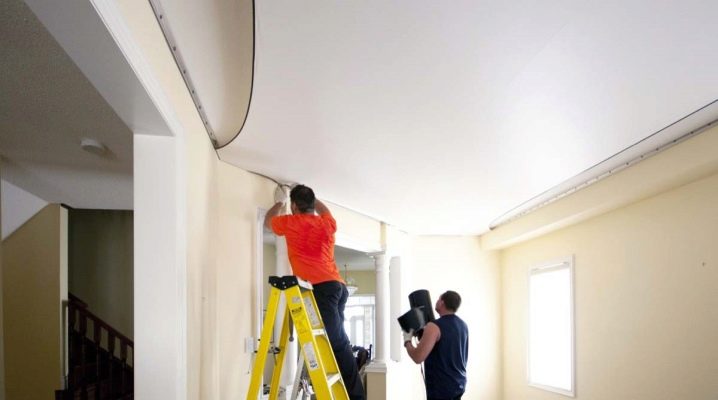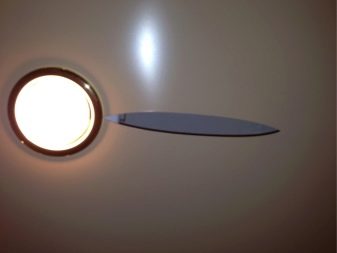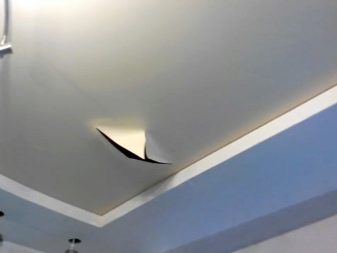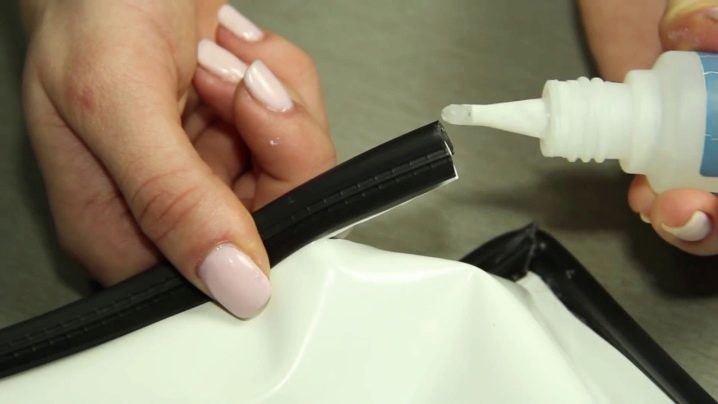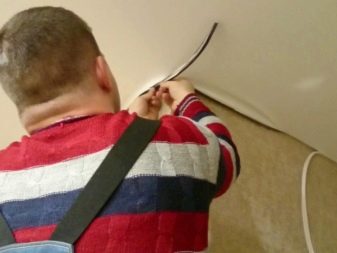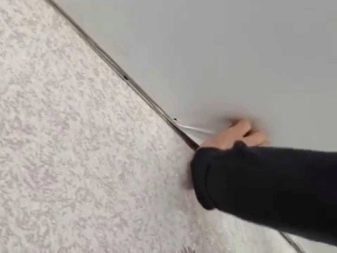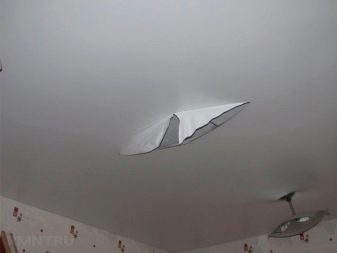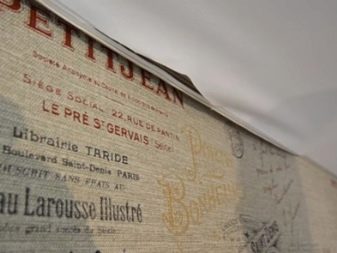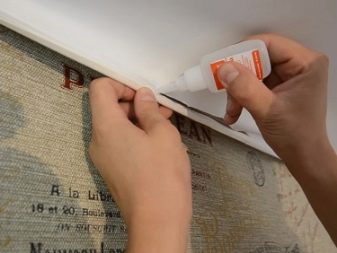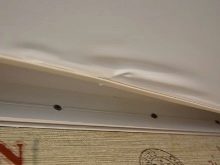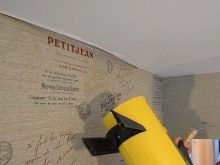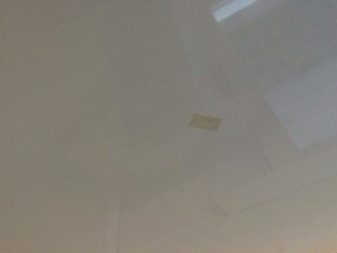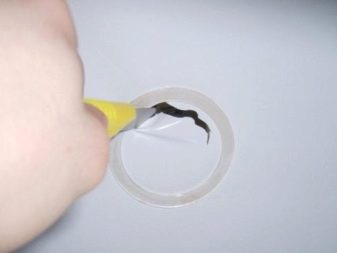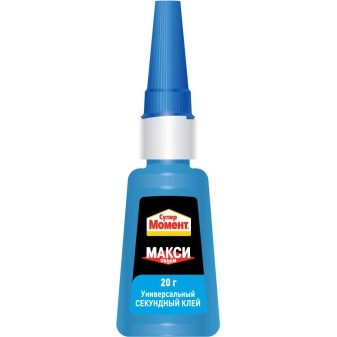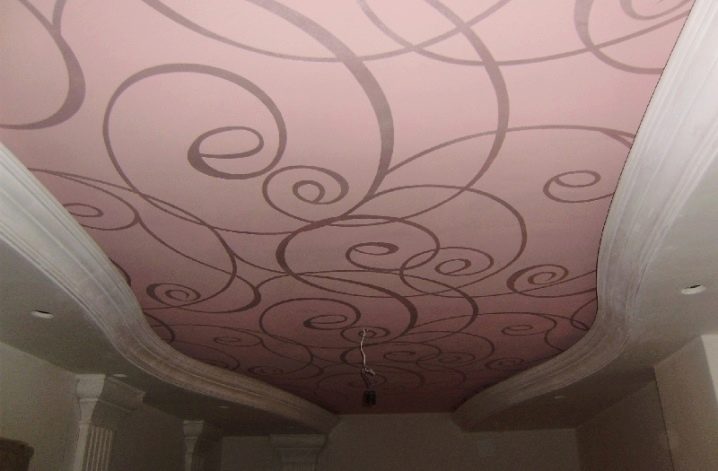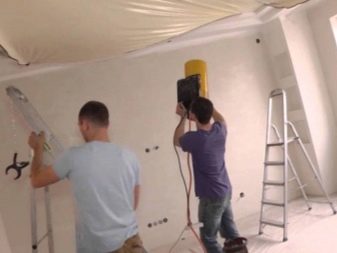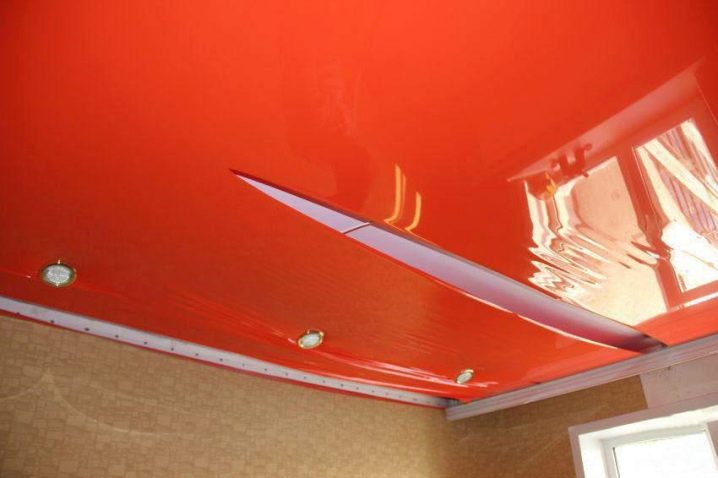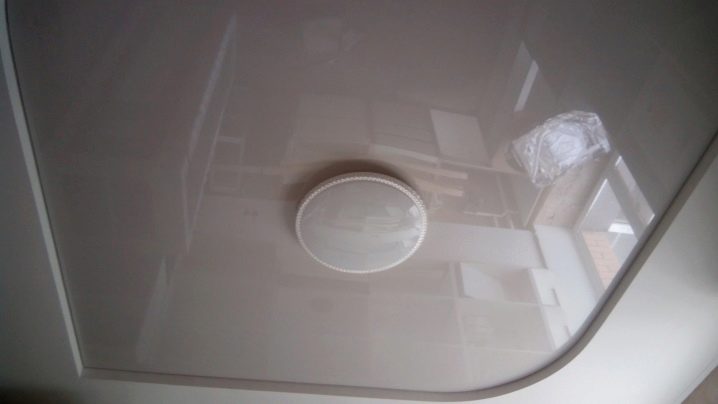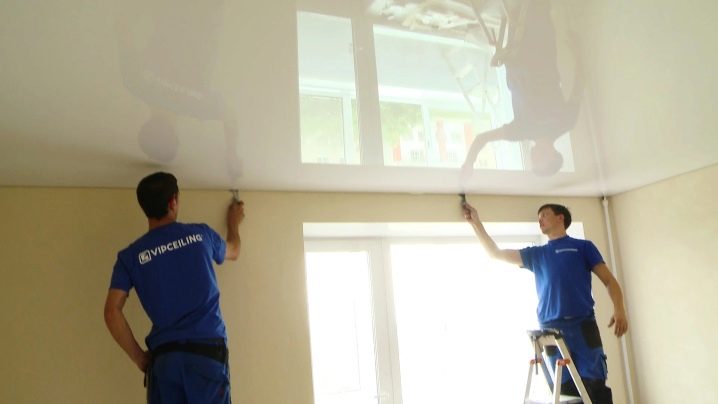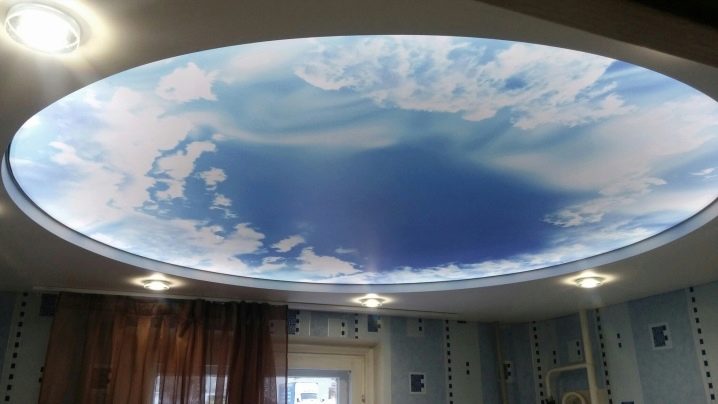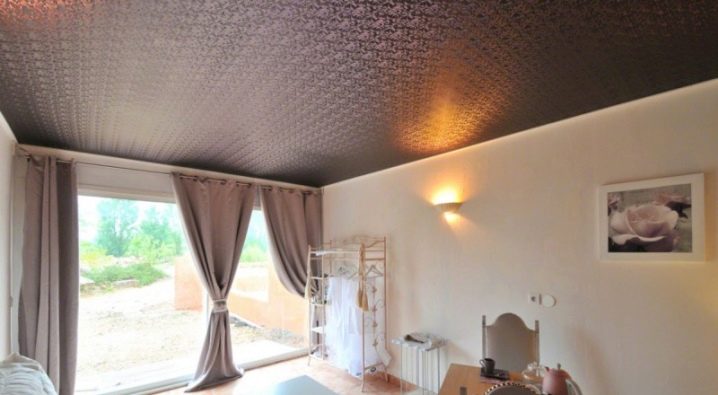Subtleties repair tension ceilings after a cut
Stretch ceiling is becoming increasingly popular. It looks great, does not penetrate extraneous noise from the neighbors above, saves the apartment from possible flooding, is practical and easy to clean.
However, he still has one major drawback - a small margin of safety. The canvas is able to withstand the load in the form of stretching and increasing pressure, but at the same time accidental contact with a sharp or rough object leads to the formation of local damage.
Special features
Features repair of suspended ceilings depend on the type of blade, the causes of the formation of a cut, its size and location of damage. It is possible to damage a cloth when cleaning, repairing, children's games or a holiday with sparklers.In any case, you need to know the tricks that will fix the problem with their own hands.
To begin, let's deal with the tension canvases. There are two main types.
Fabric
This polyester fabric, impregnated with a polymer composition. Made from synthetic fibers with a slight addition of natural fibers. In general, they are quite strong, resistant to sudden temperature changes. The average thickness is from 0.35 to 0.39 mm.
But for us, other indicators are important - porous structure and slight elasticity. Stretch them strongly impossible, which in some situations is a plus. It is easier to eliminate minor defects than on a film, due to its special structure. The canvas requires a complete replacement only if the damage on the fabric ceiling is more than 30 cm..
PVC
This canvas, which are based on polyvinyl chloride fibers. The thickness is small - 0.17-0.22 mm, but the material is very durable. It has antistatic properties, does not burn, but melts. Extremely sensitive to temperature changes, due to which cracks can form first, and then film breaks. It withstands temperatures up to + 100 ° C without losing its properties.
Very elastic - this makes it possible to stretch it a little, if the cut is located close to the baguette.But if you strongly press and stretch the film, it will change its shape and size, which will lead to irregularities and waves on the ceiling after the restoration.
Both types of stretch coatings contain polymers in their composition, but differ in their structure and web characteristics. Installation and mounting structures are also different. Accordingly, their repair will also be carried out in different ways.
Causes of damage
Even the cheapest canvas has a fairly high strength. However, one should not forget that both types of material are defenseless against piercing-cutting objects. Therefore, any, even the smallest cut can easily break the integrity of the material, its tightness and severely deform the ceiling as a whole.
From the time of installation, utmost care must be taken. In the first days after stretching, the material adapts to this state and is therefore extremely sensitive to mechanical stress, easily damaged.
On this basis, it is possible to engage in electrical work, installation of furniture and other frauds only after several days after the installation of the ceiling.
The most common causes of cuts:
- Incorrect installation, poor quality of the material itself and incorrect cutting can cause the formation of damage.
- Careless rearrangement of large-sized pieces of furniture with pointed edges. For example, moving a closet or chiffonier with sharp edges and corners.
- Active children's games. Running into the ceiling of various toys, playing with a radio-controlled aircraft, throwing the ball and the like. Therefore, the film ceiling, due to its fragility, should not be installed in children's rooms and in places where children are often.
- Inaccurate handling of sharp objects near the structure. Locksmith and carpentry tools can also serve as a frequent cause, especially with sharp and rotating edges, for example, a Bulgarian.
- A less frequent, but actual reason is a champagne cork.
How to glue?
Depending on the damage and material for restoration work, the following tools will be needed:
- fabric adhesive tape or masking tape;
- scissors, stationery tape and a small antenna cable - 10 cm;
- a patch that can be made from a piece of the remainder of the canvas;
- nylon thread, needle, paint and varnish;
- hair dryer and spatula.
The first step, which applies to all types of canvas - is to provide "first aid" to the ceiling - the edges of the cut are quickly sealed with double-sided or masking tape. This is done to prevent an increase in the area of damage.
If the cut is more like a puncture and is no more than 2 cm, you can immediately repair it, seal it with a round patch, or fill it with glue. All this will ensure the preservation of the integrity of the material and will not allow it to creep away.
Restoration of the film ceiling
First, we assess the damage, by eye determine its size and location. It is worth noting that With your own hands you can completely eliminate only small defects., as PVC film is not easily repaired.
Large cuts, more than 15 cm will not be possible to repair it yourself. Closely located to the wall - no further than 15-20 cm - damage can be pulled and hidden in a baguette slot.
- Along the cut, parallel to the baguette, we glue a piece of antenna cable. We wait until the glue is completely dry.
- After we heat the canvas with a hairdryer.
- Carefully pull it up to the baguette and refill it using a spatula.
- Straighten the canvas so that there are no waves left.
- If irregularities are formed on the sides of the cut, they should be leveled. For this we also glue the cable and pull up to the slot of the baguette.
If the defect is located far from the wall, then you can use several ways to eliminate it.
Method 1: Apply a patch cut
We take an identical cloth and cut out an oval patch from it, in size it should be 2-3 cm more than the main damage. After carefully applying glue to it, so that there is no excess. Otherwise, traces of glue will remain on the hands and on the ceiling, which will greatly spoil its appearance.
Put the shred to the cut and press it with moderate force. You can not push too hard, because folds can form. When the patch is grabbed, slightly smooth it. Such patches can be later disguised with a pattern or PVC appliqué.
PVC application is successfully used as a patch, attaching to the sealant or adhesive composition. However, it is worth adding such stickers (pictures) to entire areas so that the stretch ceiling has a visually complete look and design.
There are no special requirements for the adhesive composition used, the main thing is that it should quickly and efficiently clutch and be colorless. You can use superglue, ordinary PVA (latex), universal glue or specialized for a specific material.
For bonding, you can purchase the following forks of adhesive composition:
- All-purpose adhesive - possesses the good gluing function, thanks to the pitches which are its part.
- Specialty gluesubdivided into categories:
- for heavy materials - flizelin, vinyl;
- for medium materials - fabric, acrylic wallpaper;
- for lightweight materials - paper wallpaper.
- Regular Super Glue.
Method 2: Installation in place of the cut for the lamp
Suitable for vinyl film. A special sealing (or tread) thermal ring is glued to the damaged area, after the sheet is cut out, following the inner edge of the ring. This will be the basis for the future lamp. Such a ring does not allow vinyl to tear further and assumes the strain of tension.
If you can stick your hand in the damage, then the suspension of the lamp is mounted on the base without cutting anything.
It should be borne in mind that the wiring should not be located on the surface of the canvas and it should be mounted as if in tension between the lamps.Lamps can be replaced with a snag ventilation grille or smoke detectors, the method of their installation is identical.
More clearly repair the stretch ceiling made of PVC is shown in the following video.
Restoration of fabric ceiling
Due to its structure, fabric stretch ceilings are more resistant and easier to repair. The restoration can also be done in two ways.
Method 1
Sew kapron thread. We select the corresponding synthetic thread. Retreating from the edge of at least 3 mm, we tighten the edges. In this case, the distance from the wall does not play an important role, since the choice of the method completely depends on the size of the cut itself.
After the resulting seam process acrylic sealant. By attaching a suitable material to the fresh hermetic layer, it is possible to impart an area of damage to the texture of the fabric. After waiting until the sealant is completely dry, the fabric is completely painted with paint or applied with an ordinary brush or airbrush.
Method 2
If the incision is large, the seam will be very noticeable and will spoil the aesthetics of the ceiling. In this case, you can use the patch. Cut a rag out of cloth or glass.Apply on it a transparent adhesive composition and glue on the back side of the canvas, from the ceiling. At the same time it is impossible to press the flap too hard to prevent the ceiling from sagging. in the place of the cut.
We remove any excess material and carefully smooth the material. When the glue dries, it will be useful to cover the entire ceiling with water-based paint, it will hide the traces of recent repair work.
Method 3
It is possible to mount a thermal ring in the hole, we do everything as it does with a film sheet. Of course, these inclusions should be appropriate aesthetically and according to the rules of operation.
Possible defects
When a nonprofessional is taken for work, the risk of defects in the repair process increases. Damaged suspended ceilings, thanks to modern technology, in most cases can be repaired. However, in the beginning it is always necessary to evaluate the degree of damage and the expediency of actions.
There are cases in which restoration is simply impossible:
- If the ceiling was sold at the seams. In this case, the material must be re-tightened, since bonding can only worsen the situation.
- If the canvas has come off the wall. It is necessary to re-draw the canvas and strengthen the structure.
- Separately worth noting detached baguette, you can try to fix it yourself, without resorting to complete replacement of the web.
The rupture of the ceiling of a polyvinyl chloride film in the central region, exceeding a diameter of 15 cm, inevitably causes damage from the aesthetics of the canvas. At the same time it is possible to restore tightness.
Fabric canvas is much stronger and more resistant to damage, but it costs almost twice as much as film. However, he has his own limit to the suitability of restoration.
Tips and tricks
Some tips and recommendations for the proper operation of the stretch ceiling and repair.
- When gluing patches, the surface of the canvas must be degreased beforehand for better adhesion. You can degrease with a special spray to care for the stretch ceiling or an ordinary detergent, which should not be aggressive.
- When damage occurs, it is imperative to fix the edges with scotch tape. This is done to prevent an increase in the area of damage under the influence of the tension force.
- Damage on the canvas with photo printing is eliminated only if the cut is insignificant and is not noticeable after the restoration. If the integrity of the pattern is broken, then a new image should be applied to the ceiling.
- It is important that the temperature in the room is between 0 ° C and 50 ° C.
- In wet areas, you should promptly remove rust drops. Wipe the cloth better flannel rag, preferably colorless. For cleaning use glass cleaner without the content of abrasive materials;
- For fabric canvas, incandescent bulbs are allowed up to 60 watts and halogen bulbs up to 35 watts. For a film ceiling, incandescent bulbs are allowed up to 40 watts and halogen lamps up to 20 watts. If the values are exceeded, black traces of heat inevitably appear.
- Before you do damage repair, you need to make sure that the cause of the cut was not a manufacturing defect. That is, the cut was formed without direct mechanical action. In this case, you need to contact the company that carried out the installation, and it will conduct free repair.
- However, if the owner himself is to blame for the damage to the canvas, but the warranty period has not expired, then you should not do the restoration yourself, but it’s better to turn to professionals for help.The master will be able to repair the cut faster and with better quality, and the warranty benefits will remain in case of unsuccessful repair.
Damage to the tension fabric does not always require its replacement. Small and minor defects are easy to repair with your own hands, most often do not leave visible marks and flaws.
In any case, it is better to seek the advice of a specialist in order to properly assess the degree of damage and to do a high-quality restoration work.
